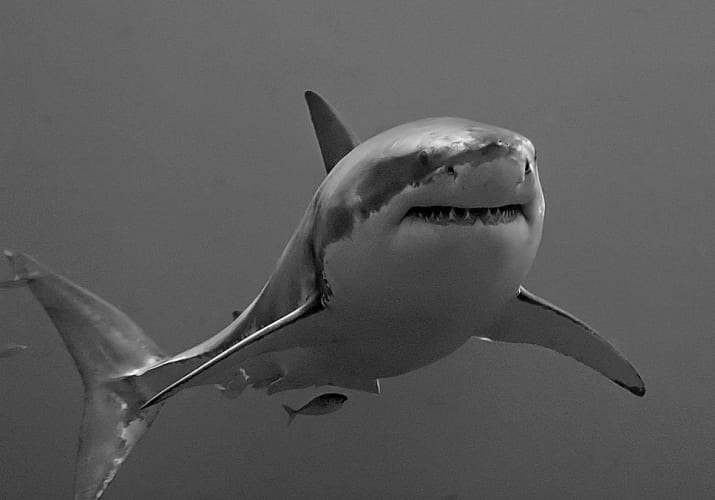Specimen of the week 221: The mega-toothed shark tooth
By Will J Richard, on 4 January 2016
Hello and a Happy New Year to you Grant-fans. So, the first specimen of the week of 2016 falls to me, Will Richard. And I’ve chosen a monster to kick off the year: possibly the biggest ever fish with teeth to match. This one was found on the 2nd January 1880 (seasonal!) but people have been puzzling over these dental discards for generations. They were originally believed to be the dried tongues of dragons but actually I think the truth might be scarier…
**The mega-toothed shark tooth**
You can’t handle the tooth
Carcharocles megalodon, megalodon or the mega-toothed shark, was one of the largest and most powerful animals ever to have lived. Described as “the all-time apex predator”, fossils suggest that they would have reached 18 metres long and weighed over 100 tonnes. They are thought to have looked similar to their extant cousins, great white sharks (Carcharodon carcharias), though were about three times the size. Mega-toothed sharks, despite what you might read (or watch) elsewhere, did not eat dinosaurs. Instead they are thought to have lived on large fish, whales, dolphins, sirenians (which contains today’s dugongs and manatees) and early relatives of seals. There was a 50 million year gap between the last dinosaur and the first megalodon, which pops up in the fossil record about 16 million years ago, and contemporaneous whale fossils have been found with deep gouges in the bones which closely match the size, orientation and serration of megalodon teeth.
Shark attack
It is difficult to be sure how megalodon hunted, but if we use great white sharks as a model, they would have attacked from beneath as prey rested close to the surface. Presumably this was as effective with air-breathing whales as it proves today with sea lions. Smaller prey would have been dispatched by a single bite to the trunk, crushing the vital organs and killing them quickly. Larger whale fossils, however, show significantly more damage to their flippers and tail bones. It appears that the shark’s first aim was to immobilise before finishing the job. Orca pods use a similar tactic when hunting big whales today.
Mmm…. blubber
Studies show that 30 kilogrammes of mammal blubber can keep a great white shark going for about a fortnight. Obviously not all mammal is blubber, though it can account for approximately 50% in some. A broad-brush estimate, therefore, would be that a medium-sized great white needs one small sea lion (weighing approximately 60 kilogrammes) a fortnight. If we scale up, a large megalodon could weigh 100 times more, so would have needed in the region of 6,000 kilogrammes of marine mammal over the same period. This equates to about four sea lions a day, or a middling whale every couple of weeks. When we consider a healthy and wide ranging megalodon population, with each shark hunting at this level, it becomes easy to understand the impact they must have had on the Cenozoic seas.

Great white shark; image by Terry Goss; CC-BY-SA-3.0 via wikimedia commons
The tooth is out there
All the evidence points to their extinction approximately 2.6 million years ago, but some theorists maintain that they are still hidden away in the deep, unexplored recesses of the sea. Now, even if we accept the idea that megalodon has managed to totally recalibrate its hunting style and now never comes to the surface, this is still very unlikely. Boring, yes, but I’m afraid true. There have been no reliable sightings, no washed up dead bits and, perhaps the clincher, no un-fossilised teeth have ever been found. Shark teeth sit in rows within their jaw, often five or six deep. As the front teeth become blunt or damaged they fall out and are replaced by the one behind. This is a constant process and some species have been recorded shedding as many as 30,000 over a lifetime. Scientists find “new” teeth from lots of deep sea sharks, but none mega enough for megalodon. Shame, really.
Happy New Year!
References
Diedrich, C. (2013) Evolution of white and megatooth sharks, and evidence for early predation on seals, sirenians, and whales. Natural Science, 5, 1203-1218.
Myers, R A et al. (2007) Cascading Effects of the Loss of Apex Predatory Sharks from a Coastal Ocean. Science, 315, 5820, 1846-1850
Semmens J.M. et al. (2013) Feeding requirements of white sharks may be higher than originally thought. Scientific Reports, 3, Article number: 1471
Will Richard is the Visitor Services Assistant at the Grant Museum of Zoology
 Close
Close



